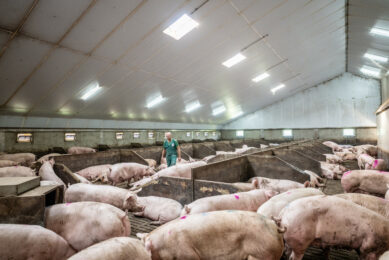Sow group housing: system doesn’t determine success
Pig farmers in the Netherlands were informed yesterday about success factors when keeping sows in group housing. A lot depends on correct and careful management, researchers of Wageningen University and Research Centre revealed.
A very important finding from the researching team was that the system of group housing does not determine the success of group housing for sows within four days post-insemination, because no effect could be seen of group housing during gestation on reproduction, welfare and condition parameters.
Group housing
The theme of group housing for sows is extremely important for any pig breeder within the European Union as from 2013, the use of conventional sow stalls will be forbidden by law. For that reason alternative housing systems have to be implemented – and ways have to be found to make these into a success.
Researchers at the university, together with a task force from the Dutch pig industry, and supported by the Dutch ministry of agriculture (LNV) carried out a multi-year research into what creates a success – and started out with a telephone interview, contacting 900 pig farmers.
The last phase of the research included the on-site observation of 70 pig farms from close by in 2008, that had already made the switch to group housing for sows. The farms were different in size and applied a variety of sow housing systems, from floor feeding to free access stalls or Electronic Sow Feeding.
Success factors
The following factors were found to be important to make group housing a success:
Management
* Farm management and farm optimisation: it is important that entrepreneurs have good management (work plan, working accurately, measuring is knowing) and attention for farm optimisation (farm objective, work plan, evaluation). These farms have a higher farrowing rate, more weaned piglets/sow/year, fewer claw problems in sows and a better condition of the sows.
* Animal-directed management: Farms with animal-directed management (attention for the needs of the individual animal) have fewer skin lesions and claw problems and better reproduction in sows. This is proved by, amongst others, the positive relationships with condition management, familiarisation of gilts with the feeding system during gestation, more human-directed sows and more living space during rearing and gestation.
Rearing gilts
* Living space: on farms with more living space for gilts, the removal rate of cycle 1+2 sows is lower and sows have fewer skin lesions during gestation.
* Feed during rearing: Farms that feed gilts limitedly and/or give them dry feed have a higher farrowing rate, a lower removal rate and a higher number of weaned piglets.
* Familiarisation with the feeding system during gestation period: Familiarising gilts with the feeding system during gestation (particularly familiarisation prior to service) is positively related to reproduction and condition of the sows.
Gestation:
* Feeding management: Too low a feed intake during early gestation can affect reproduction results negatively. In group housing with feeding stations, it is important to trace sows quickly by liquid feed. Farms that do not do this, have lower farrowing rates. Moreover, sows on farms with a lower feed ration during the entire gestation have a worse condition when placed in the farrowing stall.
* Living space: On farms with more living space/sow, the farrowing rate is higher and the removal rate of cycle 1+2 sows lower. More living space can possibly result in a higher profit.
* Straw: Using straw can positively affect welfare, because it can reduce claw disorders in situations of aggression. Moreover, straw offers animals the possibility of exerting explorative behaviour, which prevents development of stereotype behaviour.
* Cubicles with indoor exercise area: Farms with a wider indoor exercise area have a higher farrowing rate, lower sow removal rate and a better condition of sows when placed in the farrowing pen. Farms where sows are locked up during eating have a higher farrowing rate in cycle 1 and fewer claw problems.
* Feeding stations: In designing stalls with feeding stations, make sure that sows that have already eaten cannot go to the entrance of the feeding station again. Farms where this short ‘passage’ is possible have more skin lesions in sows. For farms that use straw, it is favourable for the farrowing rate to renew straw more than once a year. Furthermore, it was proved that farms with wider and/or deeper litter experienced fewer claw problems in sows.
Related website:
• Wageningen University and Research Centre (WUR)
• Dutch ministry of agriculture (LNV)











